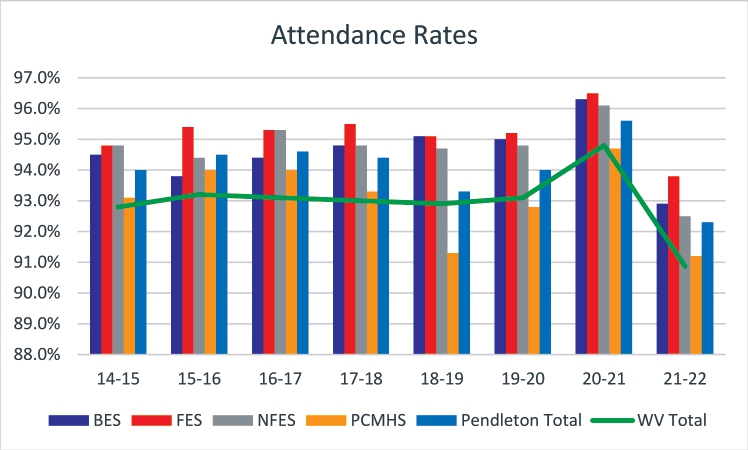Attendance chart  Hallways were bustling and classrooms chattering with the return of students to school on Aug. 18. Most classroom seats were filled every day throughout the first week of school with students eager to begin a new year. Attendance rates for each school were high, which is typical for the start of the school year. In fact, Brandywine Elementary School shared online that on Aug. 25 they had a 100 percent attendance rate. Every student and all staff members were present at school.
Hallways were bustling and classrooms chattering with the return of students to school on Aug. 18. Most classroom seats were filled every day throughout the first week of school with students eager to begin a new year. Attendance rates for each school were high, which is typical for the start of the school year. In fact, Brandywine Elementary School shared online that on Aug. 25 they had a 100 percent attendance rate. Every student and all staff members were present at school.
As the school year progresses, attendance rates across the county and state typically begin to decline with some students experiencing chronic absenteeism. Pendleton County Schools hopes to encourage families to make attendance a priority by highlighting the importance of regular school attendance.
September is National Attendance Awareness Month. To bring about awareness, Pendleton County Schools will be sharing information and resources with families throughout the entire month. According to the West Virginia Department of Education, chronic absenteeism is prevalent and concerning across the state with preschool through third grade experiencing a chronic absence rate of nearly 12 percent.
So, what is chronic absenteeism? This is when students miss 10 percent or more of the school year which equates to just two days per month. These absences, regardless if they’re excused or unexcused, translate into missed learning time resulting in a lack of fundamental reading and math instruction, lower proficiency rates, and a higher chance of being retained or dropping out of high school as students get older.
Absences occur for a wide variety of reasons, but it’s important to note that excused absences are just as detrimental to a student’s education as unexcused absences. In preschool through third grade, students are setting the foundation that will serve as the base of their learning for the rest of their schooling career. When absences occur, holes begin to form in the foundation, and it becomes extremely difficult for students to catch up. Additionally, some students experience anxiety and feel ill from missed instruction and make up work which in turn leads to additional absences.
While instruction was difficult and students across the country experienced some learning loss during the COVID-19 pandemic, schools and students have made great strides to close that learning gap. Regular attendance is a crucial and integral part of ensuring that the gaps are closed.
According to Attendance Works, a nonprofit initiative aimed at breaking down the root causes and problem solving for solutions to chronic absenteeism, there are five areas that students need in order to be engaged in school and attend regularly. These include physical and emotional health and safety, a sense of belonging, connection, and support, academic challenge and engagement, adult and student well-being and emotional competence and positive relationships which are essential to positive conditions for learning.
The old saying goes, “it takes a village to raise a child.” Everyone in the community can support and encourage regular attendance whether families and parents, businesses, healthcare providers, or elected leaders. Visit www.attendanceworks.org or contact a local school for ideas on how to help improve attendance rates and reduce chronic absenteeism.


